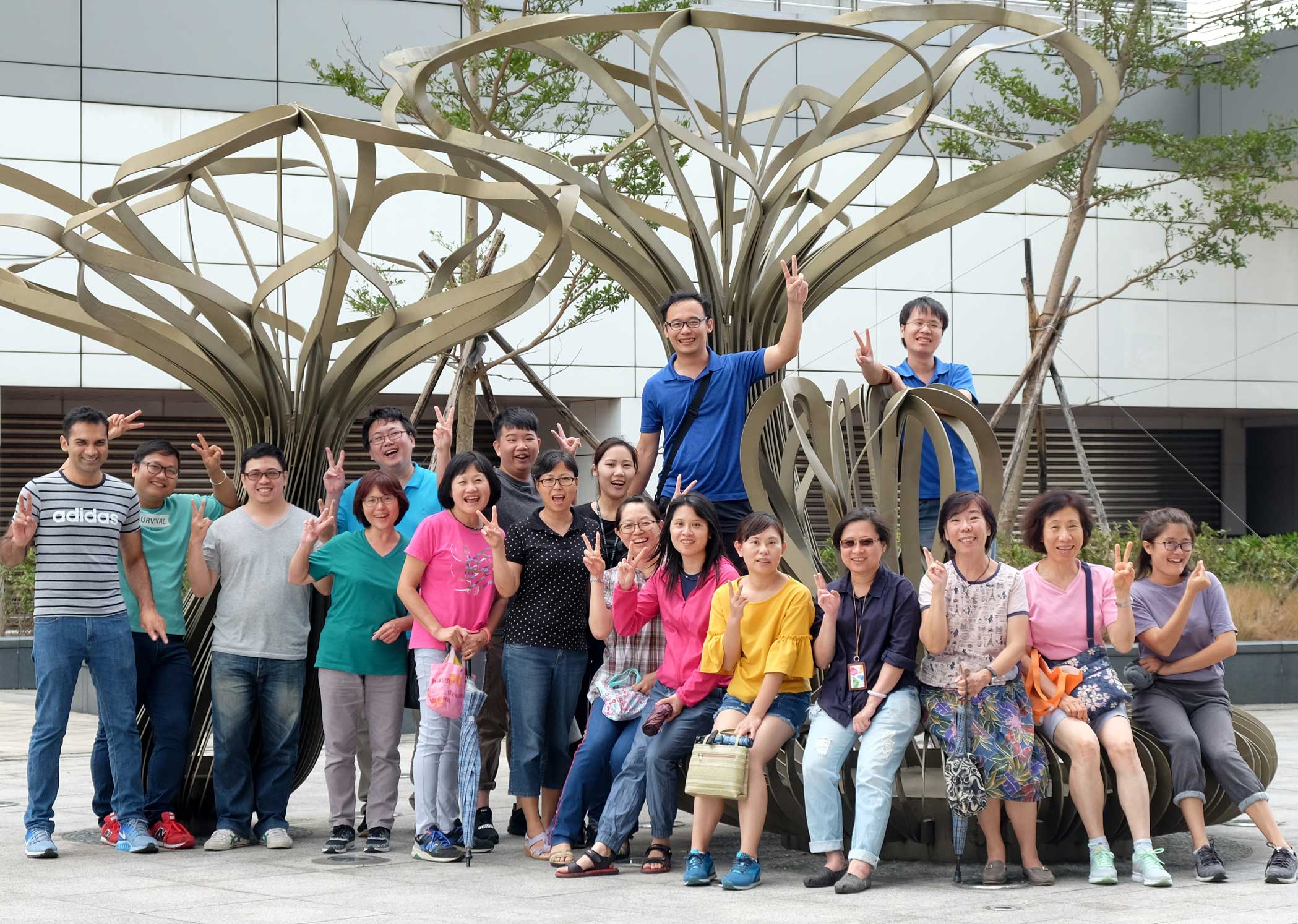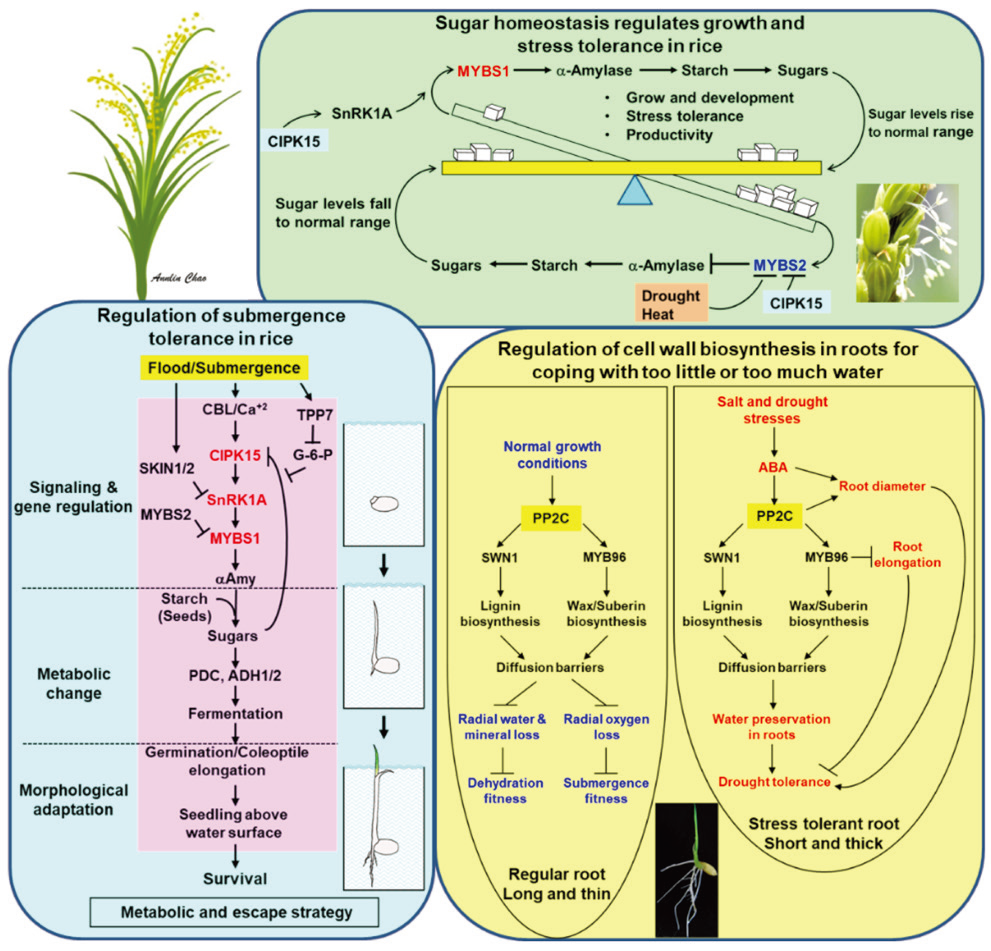Sugar and Hypoxia Signaling in Plants Mechanism of Root Development
Rice is the major dietary staple for nearly half of humanity. Developing technologies for breeding rice tolerant to multiple stresses while maintaining high productivity is important. Rice is also a powerful model for studying gene functions in cereals.
- (1) Regulation of sugar homeostasis - Sugar homeostasis is crucial for growth, stress tolerance and productivity. We study regulatory mechanisms of sugar homeostasis linked to abiotic stress tolerance and productivity in rice.
- (2) Hypoxia signaling and regulation - Most terrestrial plants are extremely vulnerable to flooding due to limited O2 for respiration in tissues submerged underwater. Rice is unique for its ability to germinate underwater and grow in water-logged soil. We study the mechanism of low O2 sensing and signaling that regulate hormone-dependent anatomical and metabolic adaptation to flooding in rice.
- (3) Root development and stress tolerance - Root architecture is essential for water/nutrient uptake that impacts growth rate, tolerance to drought and flooding, and productivity in plants. We study mechanisms regulating root architecture in response to drought and flooding.
- (4) Rice functional genomics – We generated a rice mutant population of 100,000 T-DNA-tagged gene activation/ knockout lines and a database of 60,000 T-DNA tagged rice genome sequences. This genetic resource, the Taiwan Rice Insertional Mutant (TRIM) population, is used worldwide for rice functional genomics research.
- PDF, 1984-1988, Dept. Biology, Univ Rochester Dept. Plant Biology, Cornell Univ USA
- Ph.D., 1984, Dept Plant Pathology Univ. Arkansas, USA
- MS, 1979, Dept Plant Pathology Natl Chung Hsing Univ.
- BS, 1975, Dept Plant Pathology Natl Chung Hsing Univ.
- Hong, Y.-F., Ho, T.-H. D., Wu, C.-F., Ho, S.-L., Yeh, R.-H., Lu, C.-A., Chen, P.-W., Yu, S.-M. (2012) Convergent starvation signals and hormone crosstalk in regulating nutrient mobilization upon germination. Plant Cell 24: 2857-2873.
- Lin, C.-R., Lee, K.-W., Chen, C.-Y., Hong, Y.-F., Chen, J.-L., Lu, C.-A., Chen, K.-T., Ho, T.-H. D., Yu, S.-M. (2014) SnRK1A-interacting negative regulators modulate the nutrient starvation signaling sensor SnRK1 in sourcesink communication in cereal seedlings under abiotic stress. Plant Cell 26: 808-827.
- Yu, S.-M., Lo, S.-F., Ho, T.-H. D. (2015) Source-sink communication: regulated by hormone, nutrient, and stress cross-signaling. Trends Plant Sci. 20: 844-857.
- Lo, S.-F., Fan, M.-J., Hsing, Y.-I., Chen, L.-J., Chen, S., Wen, I.-C., Liu, Y.-L., Chen, K.-T., Jiang, M.-J., Lin, M.- K., Rao, M.-Y., Yu, L.-C., Ho, T.-H. D., Yu, S.-M. (2016) Genetic resources offer efficient tools for rice functional genomics research. Plant Cell & Environ. 39: 998-1013.
- Chen, Y.-S., Ho, T.-H. D., Liu, L., Lee, D.-H., Lee, C.- H., Chen, Y.-R., Lin, S.-Y., Lu, C.-A., Yu, S.-M. (2019) Sugar regulated interactions between MYBS2 and 14- 3-3 proteins enhances plant growth, stress tolerance and grain weight in rice. Pro. Natl. Acad. Sci. USA 116: 21925-21935.
- Lo, S.-F., Cheng, M.-L., Lin, C.-W., Hong, Y.-F., Lee, K.-W., Hsiao, Y., Hsiao, A.-S., Chen, P.-J., Wong, L.- I., Chen, N.-C., Hsing, Y.-I., Reuzeau, C., Yu, S.-M., Ho, T.-H. D. (2020) RBG1 increases cell division and auxin levels to enhance seed and root development and stress recovery. Plant Biotech. J. 18: 1969-1983. (cover story)


